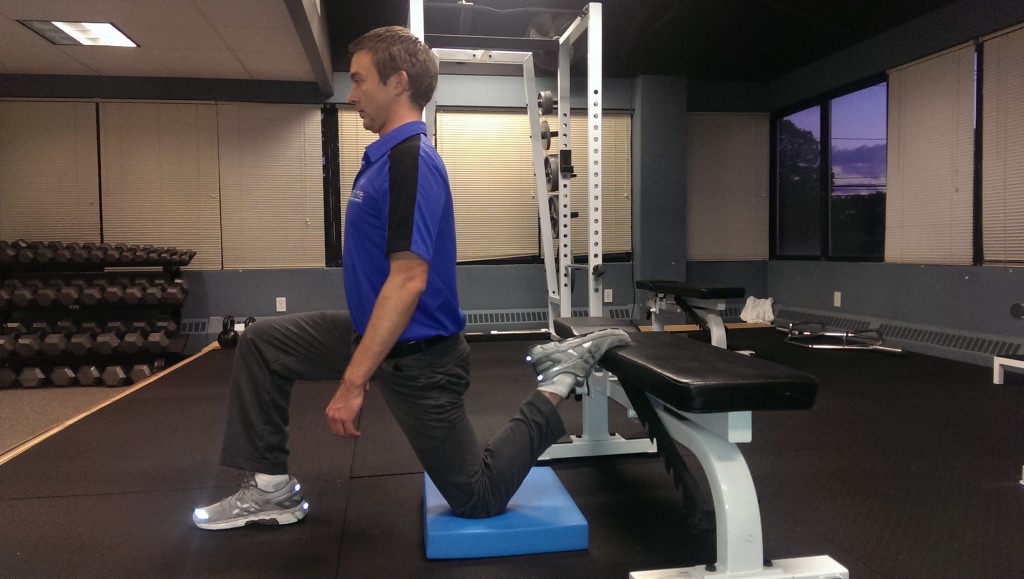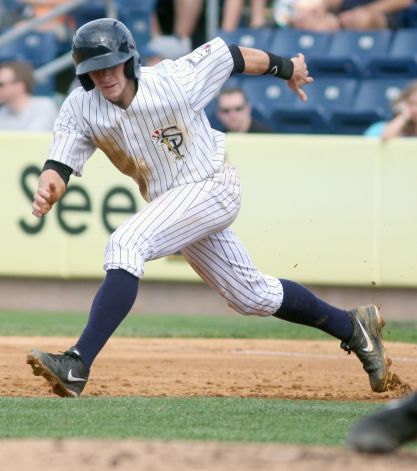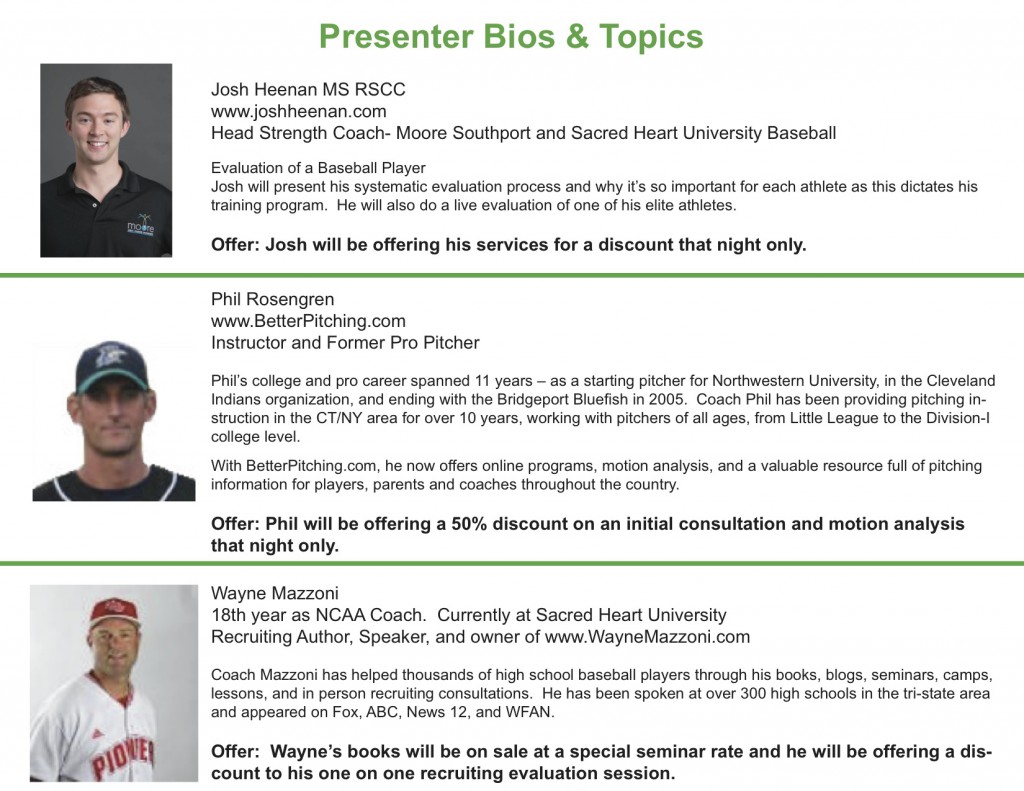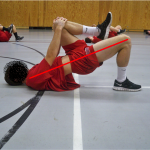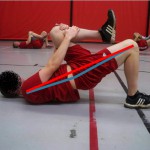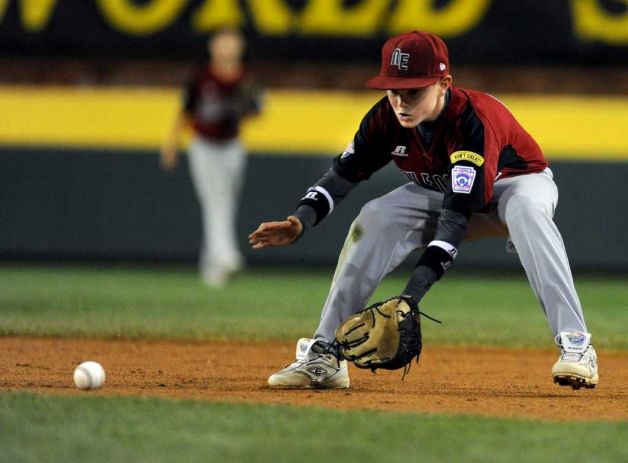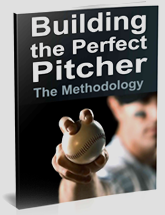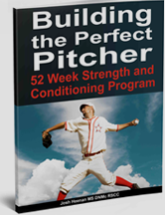5 Tips to Improve Your 60-Yard Dash

As discussed in the 60-Yard Dash: A Case Study post, the 60 is not the most applicable test of “speed” for baseball players, but it is one that will likely be around for a long time. The sprint has many qualities to be optimal; including power, strength, stability, flexibility, and plain old good movement. Without assessing someone for strengths and limitations here are 5 tips to improve your 60-yard dash.
1) Hip Flexor Mobility
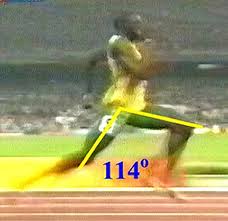 Hip flexors will often be tight and limit the amount of hip extension your leg can get. Increasing hip extension will allow you to naturally increase your stride length. If you can increase stride length without over-striding, you will cover more ground and have need less strides to complete the sprint.
Hip flexors will often be tight and limit the amount of hip extension your leg can get. Increasing hip extension will allow you to naturally increase your stride length. If you can increase stride length without over-striding, you will cover more ground and have need less strides to complete the sprint.
Quad/Posas-Hip Flexor Stretch- hold for 60 sec, while flexing the down leg glute as hard as possible.
2) Hamstring Mobility
Having good hamstring mobility will allow you to naturally extend your leg further in front of you than with poor hamstring mobility. This will again add to your stride length cutting down on the amount of strides needed.
Spider lunge with hamstring floss 10x
3) General Lower Body Strength
Squat, lunge, deadlift, sled push, and farmer’s walks all teach how to put force into the ground and will bring up base strength. Aim for a squat and deadlift of 1.5-2x bodyweight is a great place to start.
4) Specific Lower Body Strength
Single leg hip thrusters are almost the exact same mechanics as running. Squatting and deadlifting are great tools to teach general force production, but single leg hip thrusters are a better tool to apply force in the posterior direction with nearly identical mechanics as a sprint.
3-10 sets of 5-15 reps
5) Specific Lower Body Power
Repeated power with force in the posterior direction is going to carry over to sprint performance seamlessly. Acceleration, the most difficult phase to decrease in short sprints, is directly effected by the amount and quickness of the force that can be placed into the ground—exactly what the single leg trip jump reveals. Use this as your primary measuring stick in training to see if you have become more powerful.
Conclusion
There is no substitute for practicing (and video taping!) 10 and 60-yard dashes to improve your performance, but these tips will leave you more flexible, stronger, and most importantly, FASTER.
The 60-Yard Dash: A Case Study
The 60-yard dash is often one of the first quantitative tests scouts at both the college and professional levels wish to see performed well.
This test has been deeply engrained into the dogma of baseball, while science and many coaches believe that there are better options. The 60-yard dash tests acceleration, top speed, and maintenance of top speed over 180 total feet. In general, baseball is a sport of acceleration and deceleration, not top speed. Regardless of it’s applicability many coaches and scouts use it as a gauge of athleticism and should at least be a consideration for athletes wanting to been seen as competitive. Here’s a case study to show how we address improving speed.
As an incoming freshman shortstop at Sacred Heart University, John Murphy had a 7-7.1 60-yard dash. With a front squat max of 245 and a vertical jump of 25 inches his power and strength was considered average to below average for SHU’s program.
My favorite test for both power and asymmetries is the single leg triple jump (SLTJ). The test is performed by standing on one leg and making 3 consecutive broad jumps on the same side while remaining in control. The goal is to jump as far away from the starting point while sticking each landing. When there is a side-to-side discrepancy of over a foot I investigate deeper to see if we are dealing with strength deficit or something more structurally.
Scoring an average of 21 feet on each side puts John right in the middle of a team average of 22, nothing special to say the least. The ability to apply force into the ground and accelerate your body forward gives us a nice picture of single leg power and a large carryover to running.
As you can see in the chart, as the years progressed, John’s squat, single leg triple jump, vertical jump, and front squat to bodyweight ratio make improvements every year. Increasing relative strength compared to bodyweight and teaching how to increase force production once movement dysfunctions are addressed will consistently increase speed— more importantly acceleration.
An interesting fact to note when looking at the data is that John’s junior year is when he really took his diet to the next level. When dealing with athletes of all levels it clicks at different times. Sometimes this has to do with whom they spend the majority of their time with and sometimes it just takes time to see the light at the end of the tunnel with a goal. Either way, John honed in on his diet by adding about 10 lbs of muscle and dropping a few of fat, again increasing his potential to produce force and become faster.
By John’s senior campaign he had been clocked as low as 6.5 in his 60 and was easily the most powerful athlete in his program. Looking back at his freshman year 21 foot triple jump (7 feet per jump) and increasing it to 26 feet (~8 ½ feet per jump) is a very large difference. This effectively lengthens his stride without changing his mechanics and drops 3-5 strides or ground contacts during his 60-yard dash, dramatically decreasing his time to plus speed in the eyes of MLB organizations.
When training athletes, strength coaches often forget the goal of athletic performance. Our job in the weight room is to help minimize or prevent injury, increase movement efficiency, increase overall strength, and increase force production in a way that it relates to our athlete’s events. You can see we did not test vertical jumps in 2012 because after the past 6 years I have come to realize that the carry over to baseball or other athletic development is much larger with the triple jump gave me lots of qualitative and quantitative data to use in our programming compared to vertical jump data.
Tips to Increase Acceleration Speed
-Video tape and practice your 10-yard dash. Use the video to get your current time and work to improve it. Once your 10-yard dash goes down, your 60 will drop dramatically.
-Increase your front squat max to 1.7-2x bodyweight with solid depth.
-Minimize fat mass and optimize muscle mass. Murph has had his bodyfat as low as 4.5%. By carrying minimal fat mass all weight is functionally producing force.
2013 Spring and Summer Athlete Roundup
As the 2013 Collegiate Baseball season ends and summer ball is in full swing we have been fortunate to have another successful year at both Sacred Heart University and Moore Physical Therapy.
For the 5th season in a row, SHU has entered the finals of the Northeast Conference Tournament. Although we feel short to Bryant, we had many very aspects to the season including; tying the school record for most wins, All- American, All Region, and All Conference nods from their respective nominating organizations.
Privately at Moore, we have athletes coming from as far as 3 hours (each way) to train during summer ball. It’s always great to see our collegiate athletes return for the summer to keep progressing. We are ramping up for what will be a very busy fall, expecting baseball players from multiple MLB and Independent organizations, and over 40 regional high schools.
The following is a short list of some of my collegiate and pro clients competing this summer.
Notable Pros
John Murphy SS- 6th Round MLB Draft Pick- NY Yankees
Troy Scribner P- Free Agent Signee- Houston Astros
Notable Summer League Players
Nick Morrissey P- Atlantic Baseball Confederation Collegiate Baseball League
Jesus Medina 3B- Atlantic Collegiate Baseball League
Kody Kerski P- Cape Cod Baseball League
Connor Landers P- Futures League
Victor Sorrento 1B- Futures League
Ryan Crawford P- Hampton Collegiate Baseball League
Dan Wertz P- Hampton Collegiate Baseball League
Alex Farina P- New England Collegiate Baseball League
Keaton Flint CF- New England Collegiate Baseball League
Jeff Stoddard P- New England Collegiate Baseball League
Dear MLB Draft Class of 2013
Dear MLB Draft Class of 2013,
Congratulations! The countless hours of hard work playing a game you love are about to pay off on draft day. Less than 0.5% of high school baseball players ever get the opportunity to play professionally, so enjoy this moment!
Having worked with many professional ballplayers at many levels in leagues all across the country, I have compiled some tips to help you maximize your career in the pros.
-
Treat Your Body Well
You are only given one body and your healthy body is your livelihood in this occupation. You must be your own biggest advocate.Find the best network of strength coaches, position coaches, chiros, PTs, Ophthalmologist, Primary Care Physicians, and Orthopedists. Problems will arise during your career, so have a team of advocates for you in multiple disciplines.
-
Don’t Eat Like Shit
Long days and little sleep, coupled with the lack of funds and options for quality food can really wreak havoc on your body. It is well known that the US is in the midst of an obesity epidemic; this was not caused by lack of food, but by a lack of nutritious food.Learn what healthy is and learn how to cook. These changes alone can prolong your career and help you recover more efficiently.
When it comes to alcohol consumption for my college and pro guys, I advise them to minimize intake and limit it to one day a week. You are now a professional, you get paid to prepare well and perform like one. Act the part.
-
Become a Student of the Game
As in many other professions, you will be left behind if you don’t take the time to learn about your craft.Read about differences in how the game is played from different coaches. Ask questions of people who are smarter than you or have more experience. Watch video to help refine your mechanics. Keep records of outings and see how you can make improvements.
Many of you will be lucky to have very knowledgeable teammates and coaches — use them. Find mentors who have experience and perspective, and apply what you learn to elevate your game.
-
Find Other Passions
Immersing yourself in your career is a necessity if you want to reach the highest levels, but it can also lead to burn out very quickly.I have worked with athletes who have found alternative passions in art, investing, law, meditation, music, web design, and writing.
Find a constructive way to decompress between the long hours that pro ball requires.
-
Someone is Always Watching
Like it or not, someone is always watching. Learn to embrace it.On the field, screaming at umpires on every questionable call or being rude to fans after you have a tough day is not needed. Off the field, people love to pick out athletes doing things they should not be doing. You will make headlines and that is the last thing your organization wants.
You could be Matt Kemp.
Or you could be Arod.
Go viral, but for positive reasons.
-
Monitor Your Finances
I am no accountant, but I have seen many professional players drown in financial issues.Do yourself a favor:
-Watch the ESPN 30 for 30 special “Broke”
-Sign up for www.mint.com to monitor your spending -
Must Reads
I hope this post reaches many of this year and future draft picks. If you have a suggestion for new professional athletes please comment below.
Quinnipiac Men’s Hockey and In-Season Training

As the collegiate hockey season ends, I am sure many local Connecticut hockey players have taken special notice of Quinnipiac’s hockey present on the national level. Unfortunately, they fell just short of the national championship; nonetheless, they should be a contender in the coming years on the same stage.
For those who have had a chance to see the changes QU has made to their hockey facilities over the past ten years, its obvious that the school wanted to develop a national level program from the ground up. What many do not get to see is the countless hours of off the ice training that this team has put in.
Since 2008, Brijesh Patel has run the strength and conditioning for both men/women’s basketball and hockey programs. B is not only preparing his athletes for their current endeavors, but also building them to excel at the highest level of sport.
One aspect of training that seems misunderstood by many sport coaches is in-season training. Here B highlights some of his in season with his men’s hockey team. Coaches often look for their athletes to bust their butt in the off-season to build foundational strength and be ready for the on-field/ice rigors, but maintaining those power/strength/flexibility/mobility qualities takes hard work in-season.
My first goal as a strength and conditioning coach is to have my athletes healthy and be able to take the field. My second goal is to increase performance on the field. This means understanding how each training session plays a role in that week, month, and years cycle of development for each player. Yes, training can leave you tired, sore, and mentally drained, but a good strength coach will know how to adjust variables to not leave them feeling or preforming poorly. This is evident with a 2-month block where QU hockey didn’t lose a game.
Here at Moore in Southport, we aim for our athletes train in-season 1-3 times a week depending on their practice and game schedule. Saturday we had 70% of our baseball clientele in training from youth, high school, to pro. Each athlete has their own in-season program that is geared to keep them powerful, strong, and healthy. Many of our athletes set personal records while their in-season due to hitting growth spurts and having just the right amount of stimulus to perform at their best.
Solving Volleyball Knee Pain
Competitive volleyball is a sport plagued with countless injuries. One of the most common injuries reported is jumper’s knee.
Jumper’s knee, patellar tendonitis or patellar femoral syndrome (PFS) are the common diagnosis for “general” front of the knee, pain. Knee pain in a jumping sport can be incredibly debilitating as in many cases it can take as long as months to fully recover.
When looking at patellar tendonitis for our athletes; the first area of concern is the ankle. Acute ankle injuries make up a majority of volleyball injuries(Bahr & Bahr, 1997). Injured ankles often lack the proper mobility, mainly in dorsiflexion (e.g. limited motion foot towards the shin). As you can see in the images below, poor ankle mobility can lead to poor landing mechanics and put more stress to the knee and can irritate any existing knee pathologies or create new ones.

ACL Drop Test- also a good test for patients with knee pain.
After clearing the ankle, we usually attack hip mobility and glute strength. Any tightness in the hip flexors are going to limit the strength of our glutes, which often leads to poor movement at the knees and limited jumping power, both major qualities needed for successful volleyball play. A basic strengthening and test exercise for glute strength is a single leg bridge. We look for knees, hips and shoulders to be in one straight line.
Addressing soft tissue of the quads and glutes through foam rolling and manual therapy expedite the recovery time. Often with aggressive treatment we can see jumping athletes back on the court the same week.
Assessing overall movement followed by breaking down each joints function helps us paint a picture of why the knee is the culprit in pain; as it is usually not the dysfunctional area driving the pain.
Related Articles:
Ankle Instability: Rest vs. Early Mobilization by Craig Leibenson
Hamstring Dominance by Brijesh Patel
References
Bahr, R., & Bahr, I. A. (1997). Incidence of acute volleyball injuries: a prospective cohort study of injury mechanisms and risk factors. Scandinavian Journal of Medicine & Science in Sports, 7(3), 166–171. doi:10.1111/j.1600-0838.1997.tb00134.x
Little League Elbow and Shoulder Presentation
As promised, I wanted to make the presentation I gave to Fairfield National Little League public to all the coaches. The file was too large for email so feel free to download it from here along with the Dr. James Andrews Throwing Program.
Feel free to post questions or comments below.
Are High Fat Diets Healthy?
Nutrition and fitness go hand and hand, and lends me to hear all sorts nutrition questions; one of which is why my fat recommendations are so high.

Looking at research of the top health problems in the US; obesity, type 2 diabetes, coronary heart disease, and high blood pressure all have very high correlations to refined carbohydrates. (Fournier et al., 1986; Liu, 2002; Liu et al., 2000)
Fat has been historically thought of as the evil nutrient that is high in calories and leads to loads of body-fat. Fat is often the first thing thought of when thinking fast food, as it’s “fattening”. Well, those foods can absolutely be fattening due to the high calorie content, but the bigger concern in my mind is the quality of those calories. Burger King, McDonalds, Taco Bell and Wendy’s are notorious for having lots of refined carbohydrates, trans fats and processed garbage in them. Those guys are the killers.
As with all macro-nutrients, quality of nutrients is the most important factor to consider. Trans fats increase LDL (bad cholesterol) and decrease HDL (good cholesterol), which is correlated to increased heart disease and stroke risk.
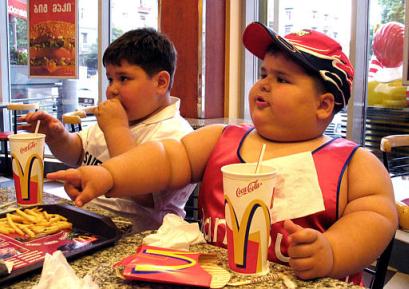
Child Abuse
The following articles give some great info on why all fats but trans fats have their place in our diets.
http://www.precisionnutrition.com/all-about-healthy-fats
http://brianstpierretraining.com/index.php/is-saturated-fat-really-the-dietary-bogeyman/
http://www.getprograde.com/Truth-About-Butter.html#.URG_aeh8u5s
http://brianstpierretraining.com/index.php/why-eggs-prevent-heart-disease/
In my experience, very few people can overeat good fats, proteins, fruits, and vegetables. When coaching clients how to eat more optimally we are constantly pushing them towards eating the right amount of calories to reach their goals, as well as the best sources to choose from.
Mastering the Perfect Baseball Off-Season, Part 2: Nutrition and Psychology

For our players—or any athlete—to make physical gains, they must also have a healthy diet and a strong mindset. So Sacred Heart’s off-season program strives to build both. Although we don’t like to brag, the results have been impressive: our team won back-to-back Northeast Conference Championships in 2011 and 2012, and one of our players used our program to pack on 15 pounds of lean muscle mass while decreasing his body fat.
Here’s how he did it—and how you can do it too. Stack.com


